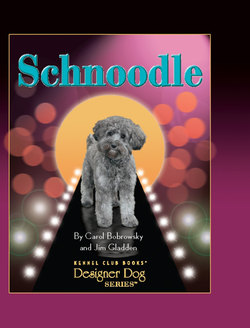Читать книгу Schnoodle - Carol Bobrowsky - Страница 11
На сайте Литреса книга снята с продажи.
ОглавлениеLounging around or hard at play the versatile Schnoodle appeals to many.
Characteristics of the Schnoodle
The Schnoodle—a cross between two beloved, centuries-old breeds—was created for different reasons than its parent breeds and is still in its infancy with respect to its development as a breed of its own. Both ancestral parent breeds were created for utilitarian purposes: the Poodle types were initially developed primarily to assist in hunting and sporting activities, and the schnauzer breeds were developed for herding cattle and later for guarding property. The desire for an allergy-friendly (i.e., low shedding, hypoallergenic), intelligent and mid-sized companion breed spurred breeders to conceive the Schnoodle hybrid. Results obtained thus far from the conscientious breeders involved in the Schnoodle’s development are quite favorable, though with some expected variability.
A Schnoodle for all seasons!
Variations can be found in the Schnoodle’s size and coat type.
SIZE DIFFERENCES
There are three recognized sizes of Poodle: Standard, Miniature and Toy. A fourth size, the Teacup, is not recognized by the AKC or the Poodle Club of America.
SIZE
Schnoodles, like people, can grow up to be different sizes as adults, even those that come from the same litter. Some siblings can become quite larger than others, while others in the litter can remain “petite.” This occasional disparity is basically a reflection of the size variability in the Poodle lines. As with Poodles and schnauzers, size classification of Schnoodles is based on body height at the withers and not on weight, due to the sometimes wide range of variation in otherwise “like” individuals. As with the Poodle, there are three types of Schnoodle based on size: standard (large), miniature (medium) and toy (small). Schnoodles taller than 15 inches at the withers are standard-type. Miniature-type Schnoodles are those that range from over 10 inches to 15 inches at the withers. Toy-type Schnoodles are 10 inches or less at the withers.
It never hurts to have big friends!
Part schnauzer, part Poodle, part mischief…
From the tip of his nose…
COAT TYPES AND COLORS
Like the parent breeds’ coats, the Schnoodle’s coat does not shed. Very little hair is lost from the coat on a day-to-day basis, and thus little dander is produced. This can be very helpful for allergy sufferers who would like to get a wonderful canine companion. The coat texture of today’s Schnoodles can range from somewhat coarse (similar to the schnauzers) to soft (similar to the Poodle) or anything in between.
Schnoodle coat colors vary from some of the solid colors of the parent breeds (black or silver) to familiar combinations (black and tan or “phantom”) to dilutions and/or blends of parent breed colors (faded apricot or faded sable with black tips). Similar to the parent breeds, coat colors can change drastically from puppyhood to adulthood. In such cases, not even the most experienced professional breeder can always and absolutely guarantee the color or shade that a puppy will become by the time he reaches one or two years of age.
TEMPERAMENT
The temperament of the Schnoodle generally reflects the best characteristics from the two parent breeds. Schnoodles are keenly intelligent and therefore are one of the easiest crossbreeds to train. Although this intelligence can cause them to be somewhat demanding of their owners’ attention at times, Schnoodles are quite eager to learn and to please their owners/trainers. They are happy, affectionate, playful, clever and very amusing. Like their schnauzer ancestors, Schnoodles exhibit a very sensible, steady and humanlike disposition. All of these qualities combine to rank them as excellent companions and family dogs.
This is not to imply, however, that Schnoodles have no challenging qualities to their temperaments. Schnoodles are often vocal and can produce sharp, piercing barks common to the schnauzer breeds. As with any other breed, if you respond properly to this type of barking and give your dog consistent positive training, your Schnoodle can quickly be taught when such barking behavior is not appropriate. Schnoodles are also like the schnauzers in that they are highly spirited and are very interested in being a part of the family—an “equal,” so to speak.
to his docked furry tail, the Schnoodle is one-of-a-kind.
General Appearance
All three Schnoodle types are roughly square when considering the proportion of body length (measured from the withers to the base of the tail) to body height at the withers. They are of moderate to rugged build with respect to muscle and skeletal frame. As with schnauzers and Poodles, the Schnoodle’s tail is docked at a very young age and the dewclaws are removed. The tail is set high on the posterior and is held happily erect when the Schnoodle is either at attention or walking. The muzzle is nearly square and of medium length, with a generous covering of facial hair. Teeth should form a scissors bite when the mouth is closed. The Schnoodle’s ears are set fairly high on the head and are not cropped.
One of the greatest hurdles to be overcome by today’s dedicated, committed dog breeders is the all-too-common “opportunistic breeders” who market typically very poor-quality and sick “random crossbreeds” to the unsuspecting public. Given the relative ease, provided by the Internet, in marketing anything without any type of validation, opportunistic breeders are flooding the dog market with, at best, unhealthy mutts. For a breed of dog to be truly developed, a standard consisting of specific characteristics and requirements must be formulated and agreed upon by enough dedicated breeders to achieve consistency among and between generations.
This affectionate Schnoodle is not afraid to show his feelings.
